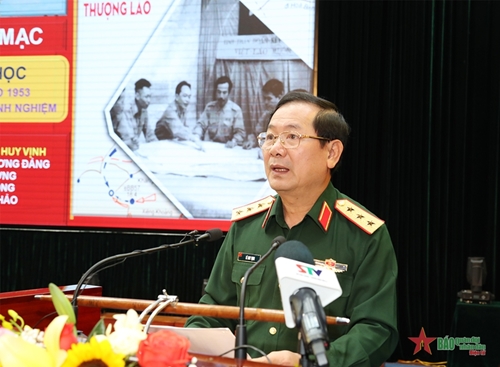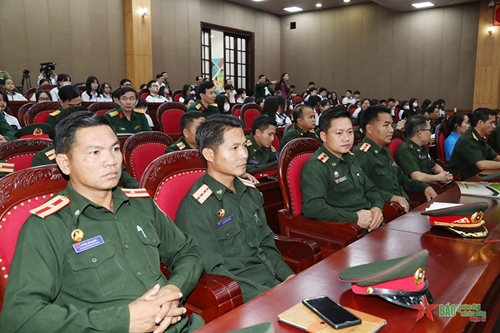The event was to mark the 70th anniversary of the Upper Laos Victory (1953-2023).
The seminar’s five-member presidium included Deputy Defense Minister Sr. Lt. Gen. Le Huy Vinh who was head of the event’s steering board, Secretary of Son La provincial Party Committee Nguyen Huu Dong, Deputy Chief of the General Staff of the Vietnam People’s Army Sr. Lt. Gen. Phung Si Tan, Commander of Military Region 2 Maj. Gen. Pham Hong Chuong, and Director of the Vietnam Institute of Military History Maj. Gen. Nguyen Hoang Nhien.
The event drew the participation of 450 delegates, including experts, historical witnesses, and students, with nearly 80 articles.
Seven decades ago, under the direction of Vietnamese President Ho Chi Minh, the Government of the Democratic Republic of Vietnam and the Lao Resistance Government decided to jointly launch the Upper Laos Campaign.
    |
 |
|
Sr. Lt. Gen. Le Huy Vinh addresses the seminar. |
With active and proactive preparations and high resolve, the Upper Laos Campaign was launched on April 13, 1953 and lasted until May 3, 1953. In just three weeks since the launch, the joint force attacked and eliminated some 2,800 enemy troops, accounting for one fifth of the total number of the enemy troops in Laos, defeated three battalions and three companies in Sam Neua, eight companies in the Nam Ou River area, and hundreds of enemy troops in the Road 7 - Xiengkhouang theater. In the period, the forces liberated five locations, forced enemy troops to retreat from 25 locations. Notably, some 40,000 s.q.km were liberated, including the entire Sam Neua province, part of Xiengkhouang province and some districts along the Nam Ou River in the provinces of Luang Prabang and Phongsaly.
Addressing the seminar, Sr. Lt. Gen. Le Huy Vinh affirmed that the Upper Laos Victory in 1953 helped expand the Lao resistance forces’ foothold, connecting the liberated areas and creating a favorable strategic position for the revolutions of Vietnam and Laos. It also contributed to consolidating the unified solidarity bloc and the combat solidarity alliance of three Indochinese countries, and at the same time pushing the French colonialists into a more passive position with the right to strategic initiative lost.
    |
 |
|
Laos participants at the event |
The Upper Laos Victory was the result of the actualization of President Ho Chi Minh's teaching on international solidarity, which reads "Helping a friend country’ people is helping the country itself" and marked a new development in the operational art of the two militaries and revolutionary armed forces. That was the first time since the resistance war against the French colonialists, the Vietnam People's Army coordinated with the Lao revolutionary armed forces to succeed in the longest and largest campaign in the Lao theater.
“That victory will forever be a milestone in the progress of the resistance war against the French colonialists, a vivid symbol of the faithful friendship and combat alliance between Vietnam and Laos; demonstrate the strategic vision, the sound, ingenious and creative leadership and direction of the General Military Commission, the General Command, and the Campaign Command," Gen. Vinh stressed.
Translated by Mai Huong